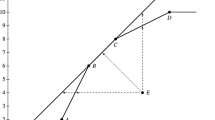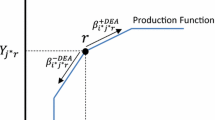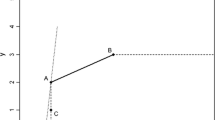Abstract
The aim of this paper is to illustrate the measurement of productive efficiency using Nerlovian indicator and metafrontier with data envelopment analysis techniques. Further, we illustrate how profit efficiency of firms operating in different regions can be aggregated into one overarching frontier. Sugarcane production in three regions in Kenya has been used to illustrate these concepts. Results show that the sources of inefficiency in all regions are both technical and allocative, but allocative efficiency contributes more to the overall Nerlovian (in)efficiency indicator.

Similar content being viewed by others
Notes
See Varian (1992) for an exposition on production axioms and convex hulls.
References
Battese GE, Rao DSP, O’Donnell CJ (2004) A metafrontier production function for estimation of technical efficiencies and technology gaps for firms operating under different technologies. J Prod Anal 21:91–103
Chambers RG, Chung Y, Färe R (1998) Profits, directional distance functions, and Nerlovian efficiency. J Optim Theory Appl 98(2):351–364
Charnes A, Cooper WW, Rhodes E (1978) Measuring the efficiency of decision-making units. Eur J Oper Res 2:429–444
Cherchye L, Kuosmanen T, Post T (2000) What is the economic meaning of FDH? A reply to thrall. J Prod Anal 13:263–267
Coelli T, Rao DSP, Battese GE (1998) An introduction to efficiency and productivity analysis. Kluwer Academic Publishers, Dordrecht
Emrouznejad A (2005) Measurement efficiency and productivity in SAS/OR. J Comput Oper Res 32(7):1665–1683
Emrouznejad A, De Witte K (2010) COOPER-framework: a unified process for non-parametric projects. Eur J Oper Res 207(3):1573–1586
Emrouznejad A, Parker B, Tavares G (2008) Evaluation of research in efficiency and productivity: a survey and analysis of the first 30 years of scholarly literature in DEA. Socio-Econ Plan Sci 42(3):151–157
Färe R, Grosskopf S (1997) Profit efficiency, Farrell decompositions and Mahler inequality. Econ Lett 57:283–287
Färe R, Grosskopf S (2004) New directions: efficiency and productivity. Kluwer Academic Publishers, Dordrecht
Färe R, Grosskopf S, Weber W (1997) The effect of risk based capital requirements on profit efficiency in banking. Discussion paper series no. 97-12, Department of Economics, Southern Illinois University at Carbondale
Fukuyama H, Weber WL (2004) Efficiency and profitability in the Japanese. In: Färe R, Grosskopf S (eds) New directions: efficiency and productivity. Kluwer Academic Publishers, Dordrecht, pp 133–146
Hayami Y, Ruttan VW (1971) Agricultural development: an international perspective. Johns Hopkins University Press, Baltimore
Lau LJ, Yotopoulos PA (1971) Test for relative efficiency and an application to Indian agriculture. Am Econ Rev 61:94–109
Matawie KM, Assaf A (2008) A metafrontier model to assess regional efficiency differences. J Model Manag 3(3):268–276
Mulwa R (2006) Economic and environmental performance of sugarcane production in Kenya: non-parametric frontier approaches, farming and rural systems, vol 84. Magraf-Verlag Publishers, Germany
Mulwa R, Emrouznejad A, Muhammad L (2009) Economic efficiency of smallholder maize producers in western Kenya: a DEA meta-frontier analysis. Int J Oper Res 4(3):250–267
Nerlove M (1965) Estimation and identification of Cobb-Douglas production functions. Rand McNally Company, Chicago
Oh D (2010) A metafrontier approach for measuring an environmentally sensitive productivity growth index. Energy Econ 32(1):146–157
Portela MCAS, Thanassoulis E (2007) Developing a decomposable measure of profit efficiency using DEA. J Oper Res Soc 58:481–490
Rao DSP, Battese GE, O’Donnell CJ (2003) Metafrontier functions for the study of inter-regional productivity differences. Working paper series no. 01/2003. School of Economics, University of Queensland, Australia
Varian HR (1992) Microeconomic analysis, 3rd edn. W. W. Norton and Company, NY
Acknowledgments
The authors thank the anonymous reviewers and Professor Constantin Zopounidis, the editor of Operational Research: An International Journal for their insightful comments and suggestions.
Author information
Authors and Affiliations
Corresponding author
Rights and permissions
About this article
Cite this article
Mulwa, R., Emrouznejad, A. Measuring productive efficiency using Nerlovian profit efficiency indicator and metafrontier analysis. Oper Res Int J 13, 271–287 (2013). https://doi.org/10.1007/s12351-011-0119-1
Received:
Revised:
Accepted:
Published:
Issue Date:
DOI: https://doi.org/10.1007/s12351-011-0119-1




